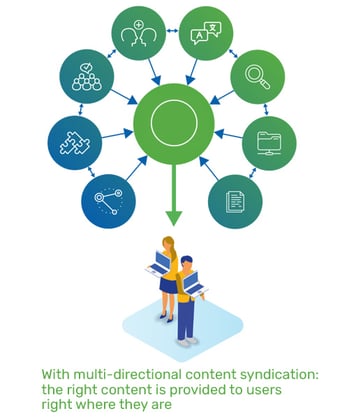Why multi-directional platform integration is essential for customer retention

In today’s fast-paced, informationally overloaded world, the most precious resource is time. There’s a reason that ChatGPT gained 57 million monthly active users in its first month of availability*: for certain tasks, it can serve up information in seconds that would normally take hours, days, or even weeks to research. We’ve all heard the phrase “time is money,” but it really goes beyond that. Time represents opportunity, and these days, nobody has any of it to waste.
The problem of finding the right information is as old as the internet itself. The problem was initially solved by crude tools such as lists of links to specific documents. Search engines revolutionized the internet by being able to serve up relevant websites in a few seconds, helping cybernauts as they bounced around from one platform to another in their hunt for information. Today, we take search engines for granted, and they certainly still have great utility, but their limitations are becoming more evident as users grow increasingly sophisticated.
It’s no longer enough to expect users to hunt for the right information. They increasingly expect to simply indicate search intent and have the information served up to them instantly without having to look around, a paradigm shift that has major implications for how users engage with you. Customers are coming to you seeking answers from your subject matter experts (SMEs) and other information. They don’t want to waste time looking around—they expect you to provide what they need, quickly, or they’ll look for it elsewhere.
The old “needle-in-a-haystack” approaches no longer work. In this article, we discuss how organizations can enhance customer value by quickly delivering the right information and expertise to their customers wherever they are.
Islands of information
As companies evolve and grow, they accumulate disparate sets of information and knowledge, like volcanic islands breaking sea level one by one, creating an archipelago of dispersed value. This is a natural process that can be beneficial to individual departments and groups within an organization, but over time, can lead to significant confusion for customers. The more properties an enterprise has, the more effort it can take a customer to find the specific information or expertise required.
Here's a scenario we commonly see in the enterprise community space. A customer comes to an online community to ask a product-related question but posts it in the wrong place, so a moderator redirects the customer to the appropriate community. Even this seemingly simple interaction involves a lot of steps, some of which are decidedly not customer-friendly. Consider what’s involved here:
- Customer registers in community #1 and finds the right place to post.
- Customer posts in community #1.
- Moderator identifies the post as being relevant to a different community.
- Moderator advises the customer to repost the question in community #2 (possibly not even providing a link!)
- Customer leaves community #1 and searches for community #2.
- Customer accesses community #2.
- Customer potentially goes through the registration process again, this time in community #2.
- Customer finds the best location within community #2 to post the question.
- Customer posts the question in community #2.
- Customer monitors community #2 for a response.
Talk about putting all the burden on the customer!
Of course, and unfortunately, the customer may not bother with all this. The customer may just say “forget it” as soon as the moderator attempts to redirect, instead opening a support ticket, searching outside the company’s ecosystem—or simply not getting support at all.
The value of multi-directional integration
It doesn’t take advanced training in customer experience management to recognize that the scenario outlined above will not result in a delighted customer eager to do more business with the company. It’s no longer acceptable to expect users to know which site, community, or thread is the right one to use when asking for information. It’s the organization’s job to understand customers’ needs and provide the right content to them where they are. 
The key to making islands of information accessible and user-friendly is building bridges between them, a method we at iTalent call multi-directional integration. Successful integration involves a combination of processes and technologies, notably automation and dynamic cross-platform syndication.
Automation is key to syndication due to the sheer volumes of information involved in modern platforms. Without it, the only way to achieve any level of syndication is through manual replication, and you probably already know what a cumbersome, expensive, and error-prone process that is. Due to the high costs and unreliability of such efforts, what often ends up happening is no syndication at all.
Automation alone isn’t enough, though. It’s necessary to have functionality that dynamically and multi-directionally syndicates content so interaction with it in one place is surfaced in every other relevant location. This needs to apply across not just different aspects of one information type but all resources in the organization, whether it’s a knowledge base, a FAQ in an online community, or a message in the CEO’s personal blog.
The value of promoting subject matter experts (SMEs)
The example outlined above may seem to be narrowly about user interactions in online communities, but it really represents a much larger issue. Sometimes customers are looking for specific pieces of information, but at least as often, they are really seeking out organizational wisdom. Your subject matter experts are the bearers of that wisdom, and multi-directional integration enables efficient connections between them and the customers seeking them out.
On a practical level, SMEs add a lot of value to communities by answering questions and making references to contributed accepted solutions, which helps reduce the creation of support tickets. Interaction with SMEs helps customers feel like they are being helped on a personal level, as opposed to the impersonal feel of a manual or knowledge base entry. Many subject matter experts are consultants or engineers with their own businesses and respond to customers to help both others and themselves. Syndicating SME responses to a broader audience helps promote them and keep them engaged on the platform.
Multi-directional syndication is a win-win-win:
- The company benefits from higher customer satisfaction and loyalty scores by adding more value to a broader base of users.
- SMEs get more widely recognized, promoted, and exposed to a broader audience, which motivates them to be more active on the online communities and add more value to users.
- Customers get access to support and expertise in a timely and effective manner.
Bridging the islands through multi-directional content syndication
Let’s go back to our previous example of a customer who posts a question in one community and is redirected to another. Here’s what the process might look like with multi-directional syndication implemented:
- Customer registers in community #1 and finds the right place to post.
- Customer posts in community #1.
- Moderator identifies the post as being relevant to a different community.
- Moderator syndicates the post to community #2.
- Moderator informs the customer that the post has been syndicated and that any answers will automatically populate to their question in community #1.
- Customer monitors the original thread for responses—no further action required—and also now has a convenient link to community #2, in case it is of interest.
Notice how much simpler and more streamlined this is for the customer: The number of steps after posting the original query has been reduced from eight to four. The customer also no longer has the impression of having done something “wrong” and thus having been bounced from one place to another. Furthermore, this new process gets relevant content faster to a broader user base and enables new connections between users and SMEs.
Integrating globally with machine translation
English is the current lingua franca of the world, and that includes the internet. Most resources on the internet use the English language, and many individuals in non-English-speaking countries learn English in part to be able to communicate with others online.
Because English is so widespread online, it can be tempting for some organizations to just assume that English is enough and call it a day. However, this is a strategic mistake: It means a poor experience for those who are not strong English speakers and missing out on countless millions of possible customers who do not speak English at all.
Fortunately, modern technology means that it’s not necessary to make this choice at all. Artificial intelligence systems include powerful, dynamic machine translation capabilities that can work on the fly to translate between English and other languages. Functionality of this sort can be added to multi-directional content syndication so that people speaking a variety of languages can seamlessly engage together in a single thread. Everyone can see content in their preferred languages, no matter what language was used to originally create it, thereby democratizing information by enabling equal access.
The power of consistent user interfaces
Note also that while our example above was based on a community forum thread, the same process can be used for content of any type, including images, audio, video, etc. Any cloud platform can be integrated, so you can bridge “islands” both within the organization and outside it, such as CRM systems, collaboration platforms like Slack or Teams, blog platforms, or social media.
In addition to the primary benefits described earlier of allowing customers to access data from a variety of locations all in one place, there’s another important advantage when doing multi-directional syndication with external resources: a consistent user interface. Customers often don’t have the time or “mental space” to learn how to read, register at, and interact with a host of different sites and platforms. Syndication allows you to present information from many different sources in a single, consistent user interface with which your users will already be familiar, enhancing customer satisfaction and retention and improving the potential for further engagement.
Ready to bridge some islands?
iTalent Digital has a proprietary integration-platform-as-a-service solution called SmartConX that makes multi-directional content syndication and dynamic machine translation fast, easy, and cost effective. Seamlessly integrate your enterprise community with social media, Salesforce, Teams, your technical knowledge base, or any cloud platform to get relevant content where your users choose to be. To learn more, visit our enterprise community practice web page, read an article about the benefits of integration platform as a service (iPaaS), or contact me at community@italentdigital.com.
You may also like:
Threats and opportunities of generative AI for enterprise communities
5 box-bursting innovations for your Khoros community
10 steps to a ubiquitous online community



